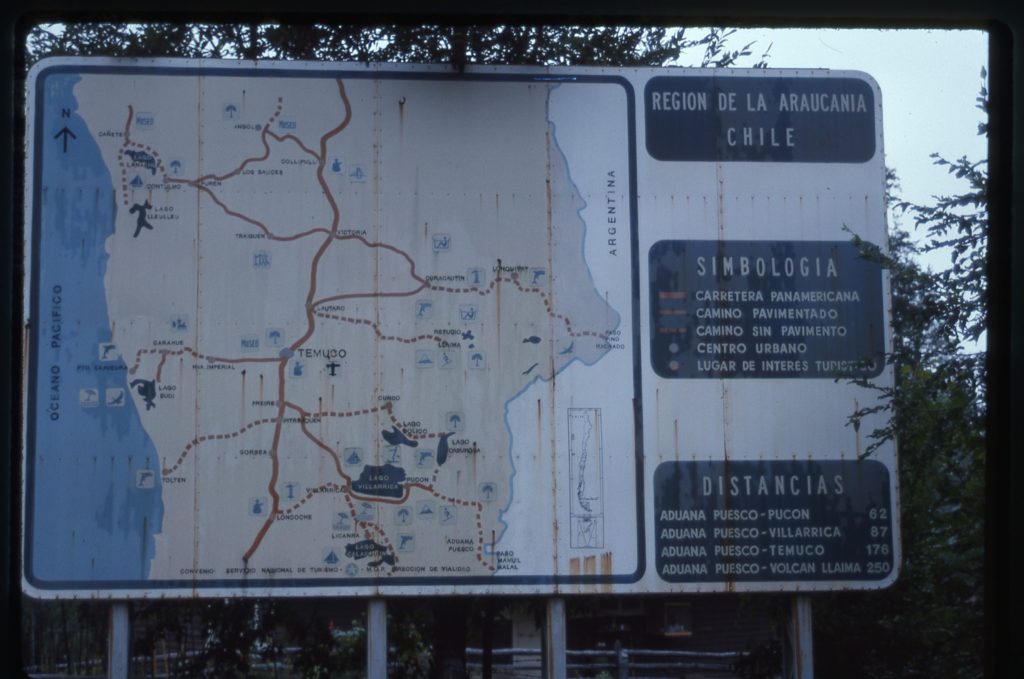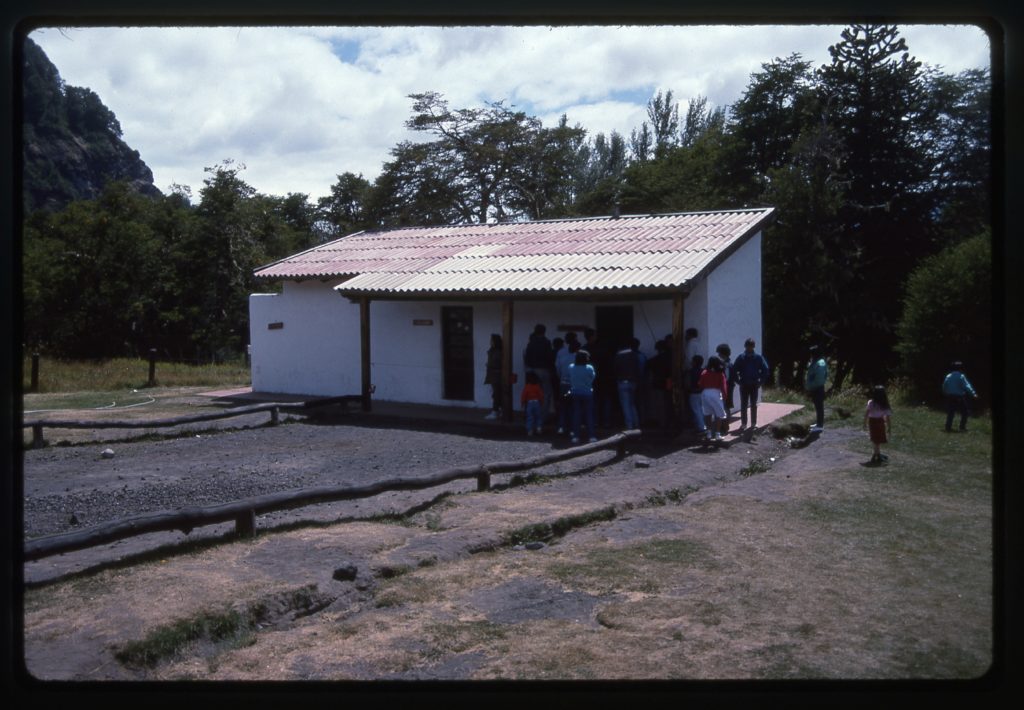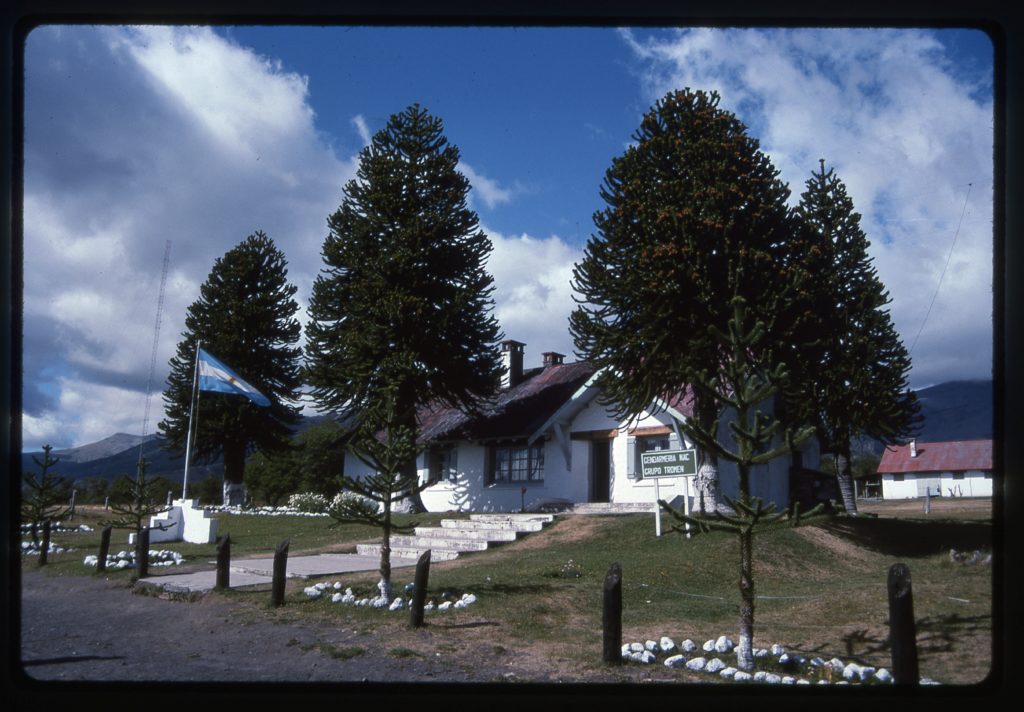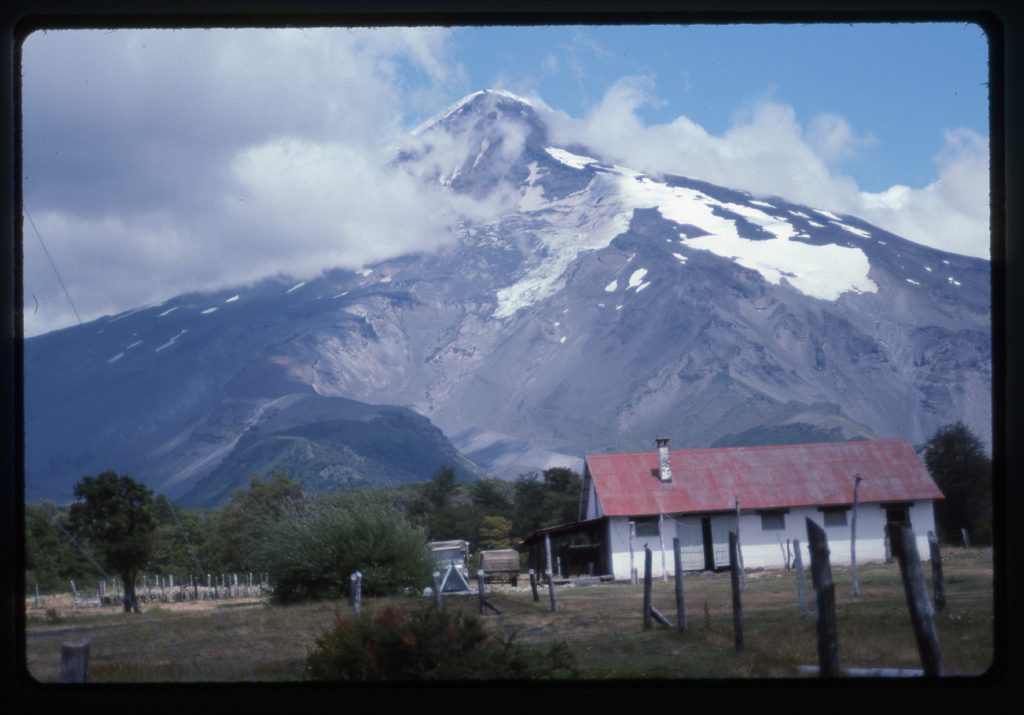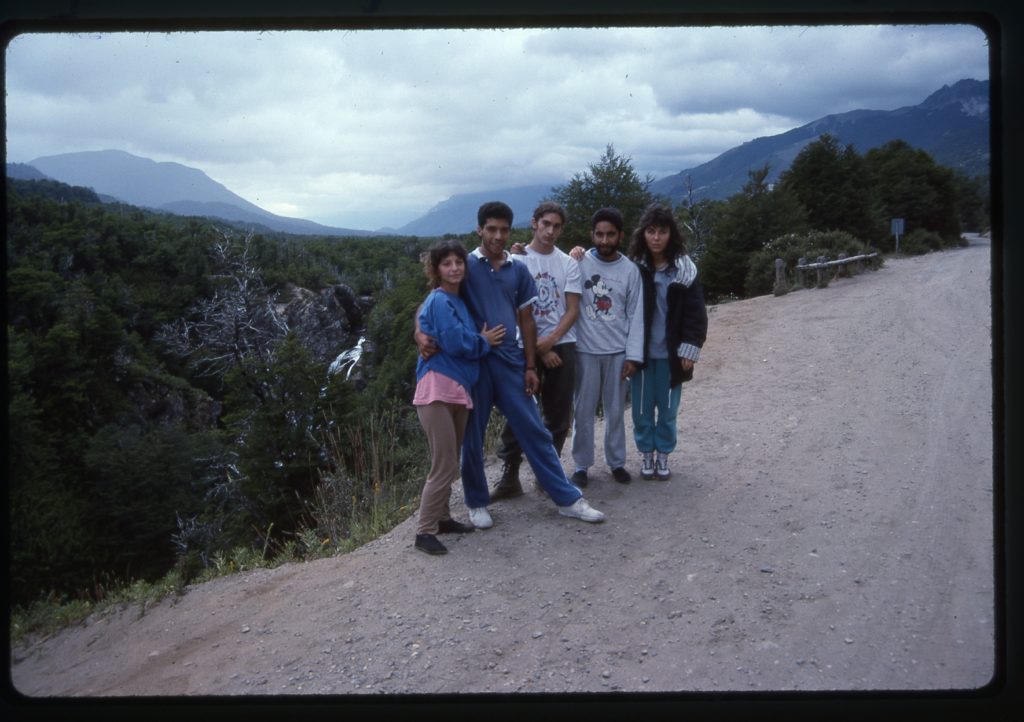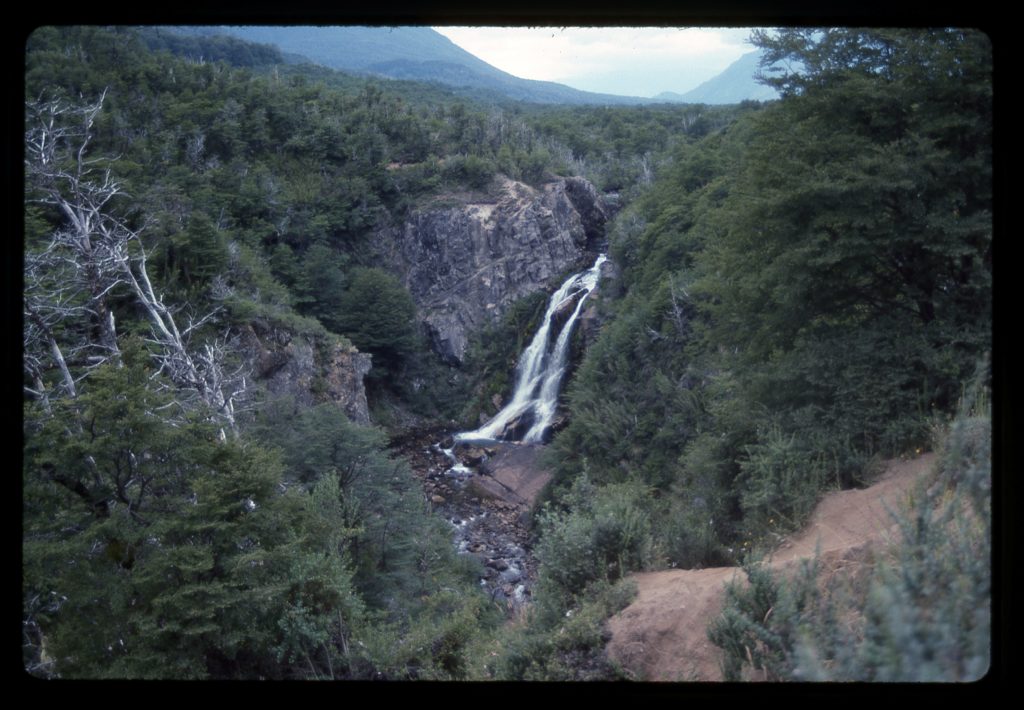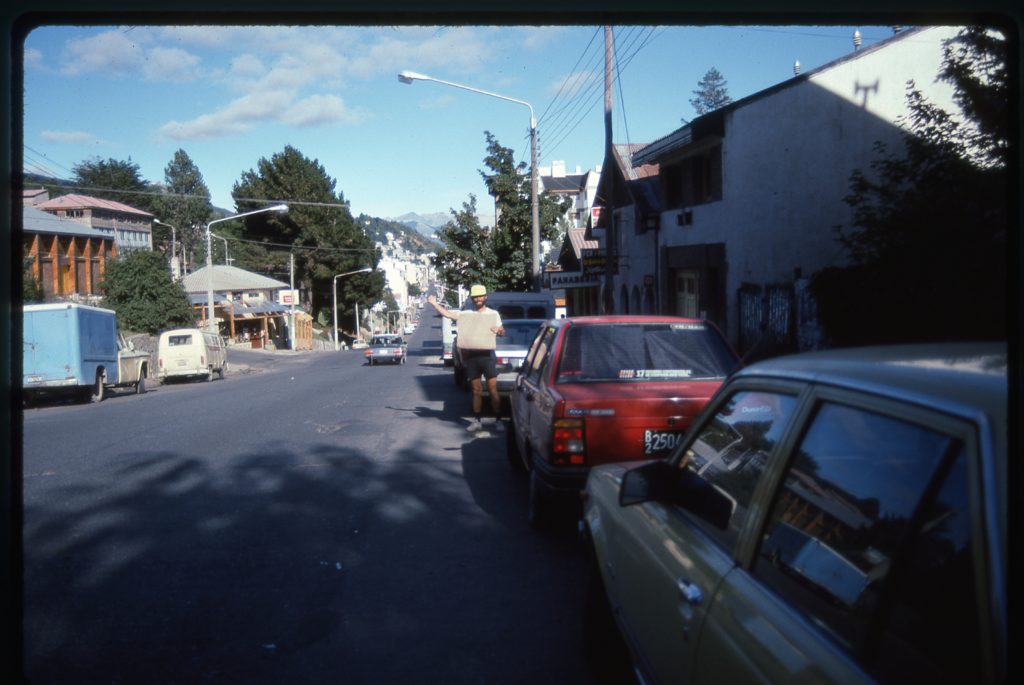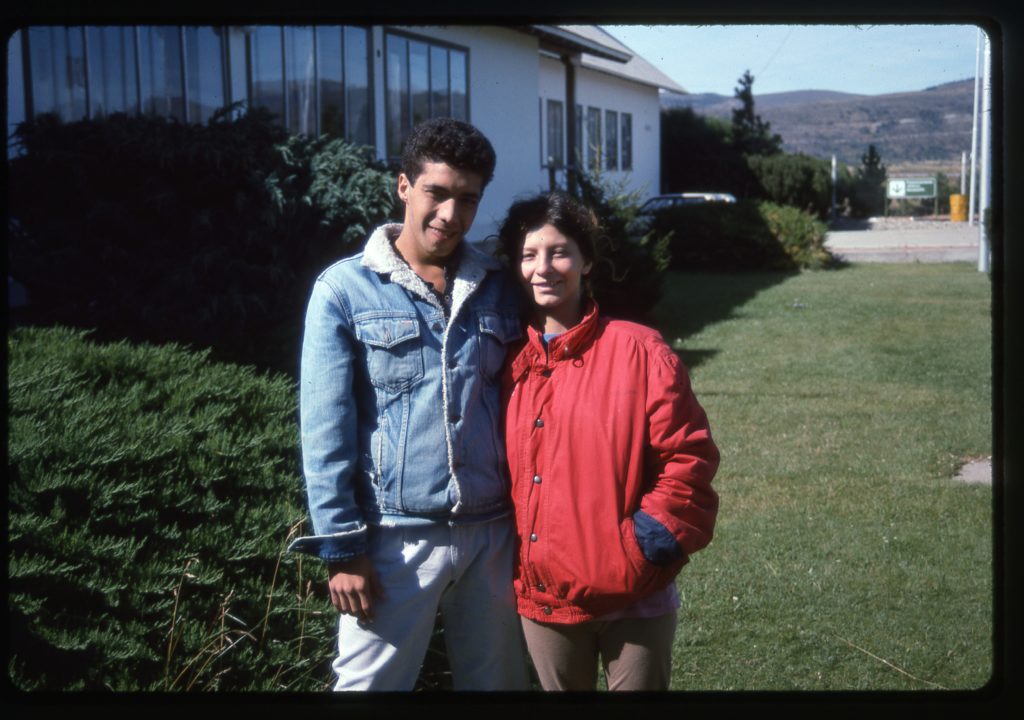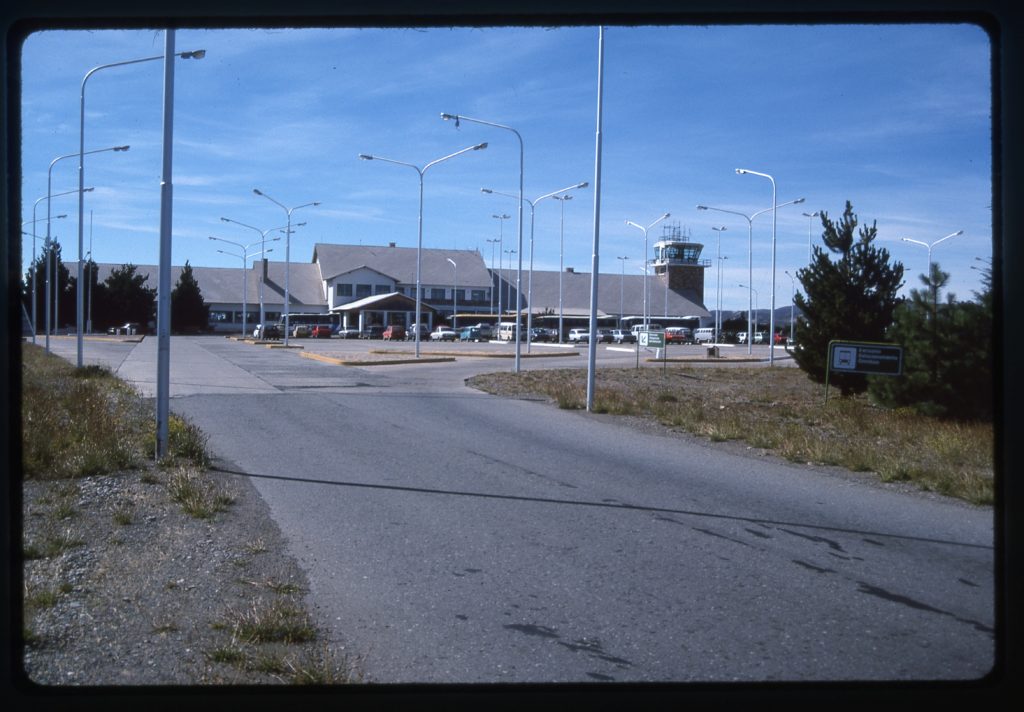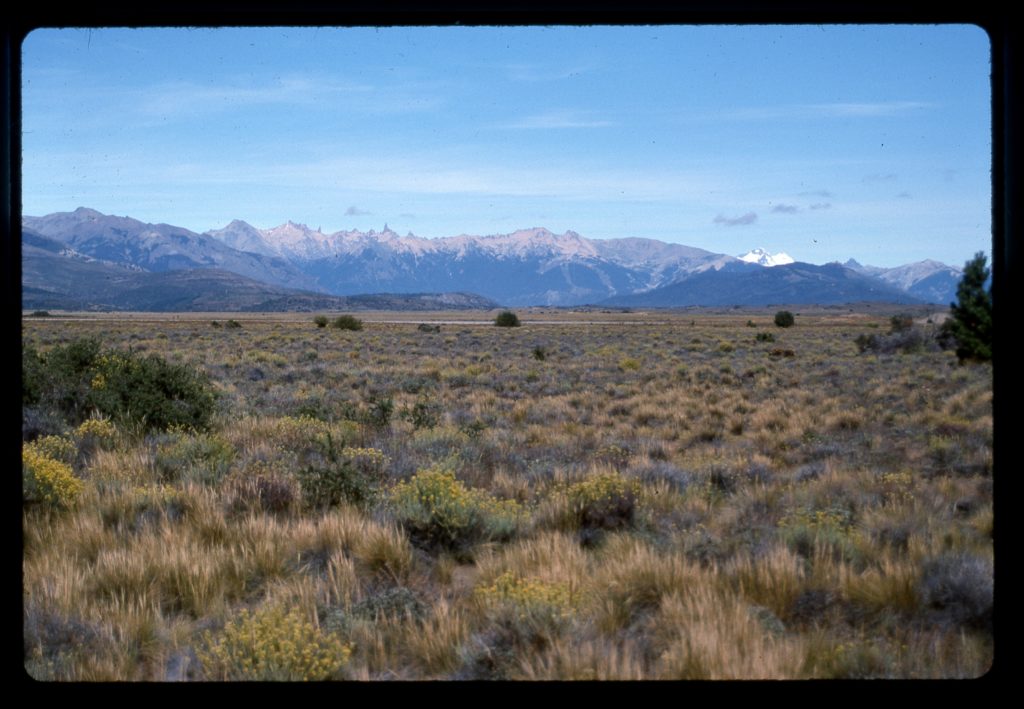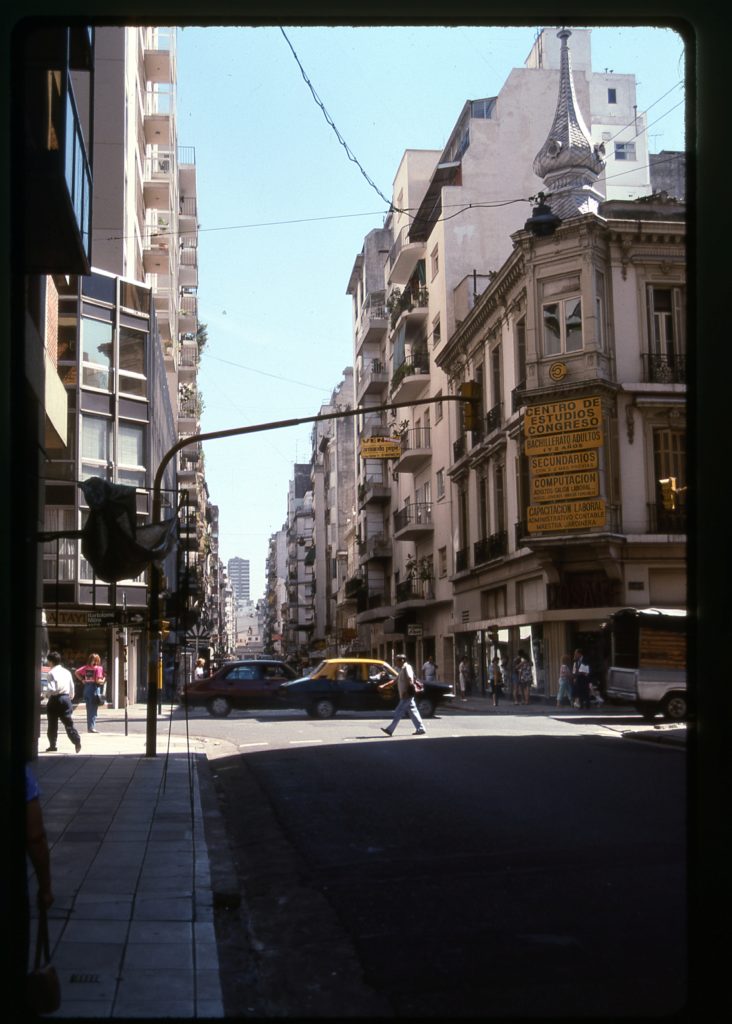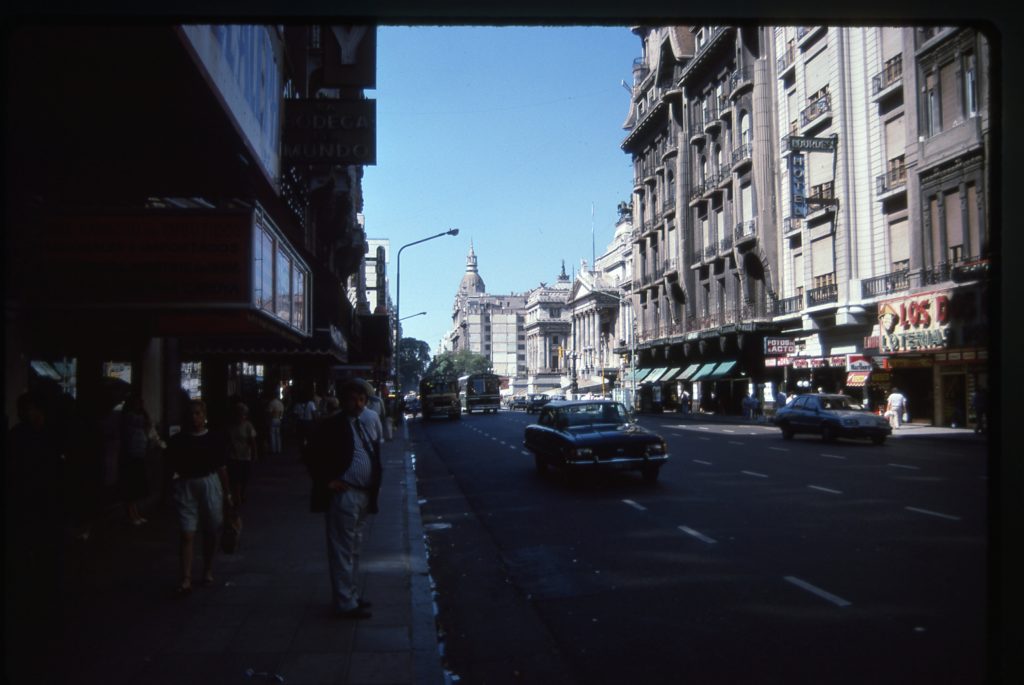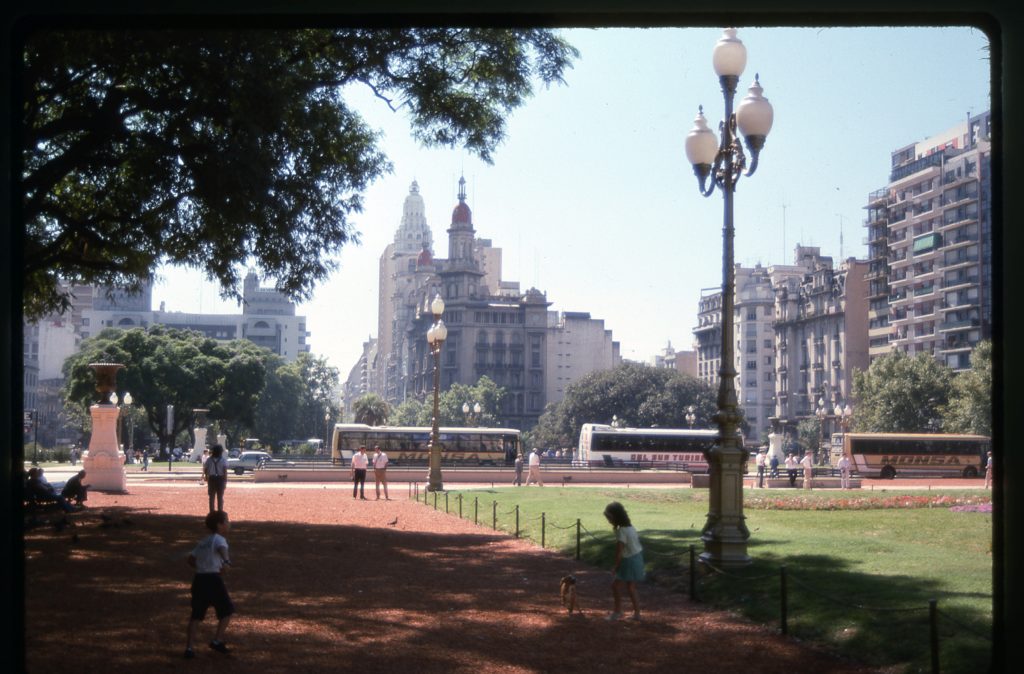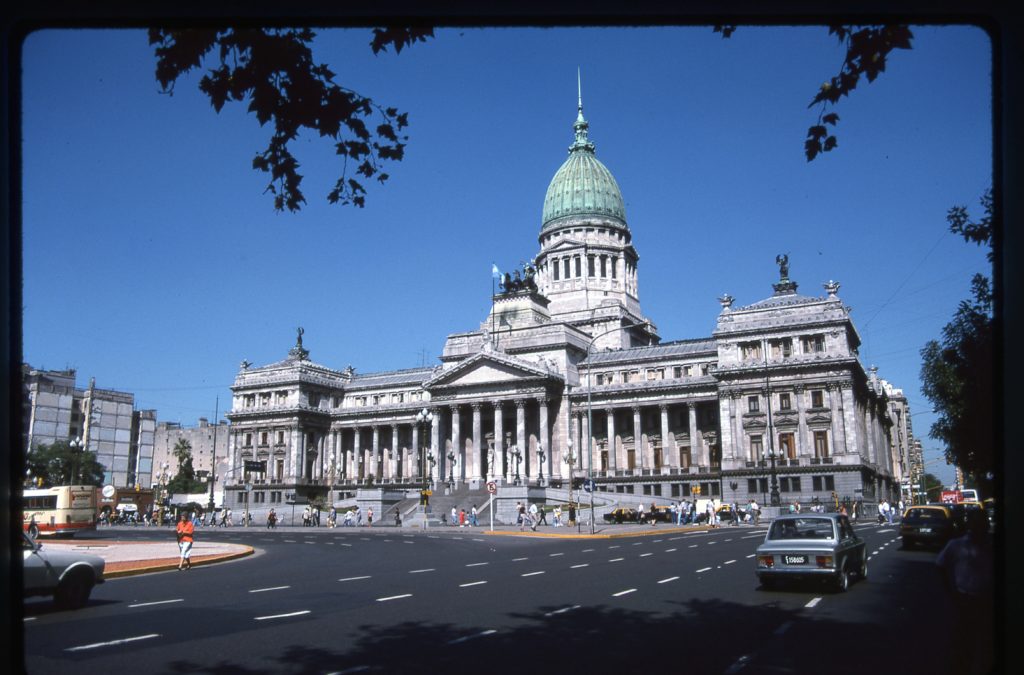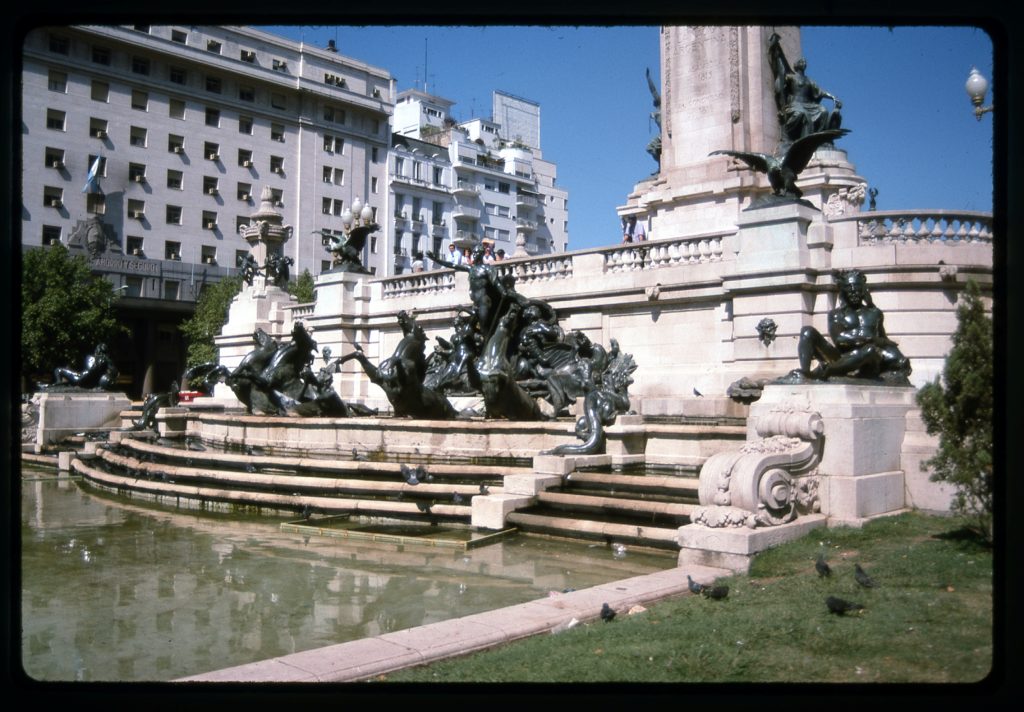Saturday, February 9, 1991
After a short sleep, I arose early, ate some food in my room, and walked the 2 blocks to the bus. It was still pitch black, and when I got to the station I saw there weren’t many passengers. We were all bound for Argentina, and my plan was to make it all the way back to Bariloche today, because tomorrow I had a plane to catch. We pulled out at 6:00 AM and headed east. The interior of the bus was plastered with “no smoking” signs, but right away the driver lit up, and what a chain-smoker he turned out to be. I pointed out the error of his ways and asked him to please not smoke, but he loudly informed me that the rule did not apply to him, and that he would smoke as much as he pleased. I suppose it didn’t help any when I told him he was a real asshole.
The blacktop turned to gravel, and we motored on – it was now broad daylight, and the scenery was terrific. We drove for miles along the Río Trancura, set in a deep valley. The peaks on both sides only rose to about 6,500′ but still wore a coat of snow on their summits, even at the height of summer. Finally, we arrived at a place called Puesco, 40 miles from Pucón, and although not yet at the border, this served as the checkpoint for Chilean customs.
There were two other buses ahead of us, so we had to wait our turn – it took 2 1/2 hours just to have the privilege of leaving Chile. Of course, we all had to produce our passports and some of us endured having our luggage searched, but it was no big deal. Once done, we left and our route climbed steadily, taking us up into the clouds. The road became narrow and precarious, then followed the shore of Lago Quilleihue, finally dropping again to cross the border into Argentina. A third of a mile in, we arrived at the Argentine customs post of Tromen.
As bad as it was to clear Chilean customs, it was even worse on the Argentine side – their officials checked every bag, every bit of luggage. It was an ordeal that lasted another 3 hours.
Talk about government bureaucracy and nonsense. It’s as if they were doing their best to intentionally piss us off, and they succeeded. The only saving grace was the scenery. The first thing one noticed was the monkey puzzle trees, native to this area, and the official tree of Chile.
But much more obvious than the beautiful trees was a huge mountain nearby, dominating everything – the Lanín volcano. It stands at 12,388′ in elevation, and has 8,609′ of prominence. I wished I’d had more time to attempt a climb – apparently it’s pretty straightforward.
Well, finally, after a total of more than 5 hours of border nonsense, we boarded our bus and lurched on down the interminable dirt road and arrived at a town called Junín de los Andes at three in the afternoon. It was very dry and desert-like here, and there was no snow on any of the nearby mountains. We were now in Neuquén Province. At the station, we changed buses, and after another ride of half an hour arrived at a town called San Martín de los Andes. This place was different – set in a deep valley, mountains towered 5,500′ above it. There was a ski area, and Lanín National Park. Very forested, it had a nice feeling. A big lake, Lago Lácar, sat on the west side of town.
It was 4:00 PM when we arrived at the bus station. Everyone disembarked and soon I had the place to myself – it was deserted, except for a girl at a kiosk. She informed me that there were no buses until eight o’clock the next morning, and that earliest bus wouldn’t arrive in Bariloche until 11:00 AM. That would be a problem, as I’d almost certainly miss my flight back to Buenos Aires. What to do? If we hadn’t spent 5 hours working our way through the border, I’d have made the earlier bus and would’ve been sleeping in Bariloche tonight. I didn’t have much choice – I’d have to try my luck hitching a ride.
Once Kiosk Girl understood my plight, she helped me letter another cardboard sign (the latest in a long line of them), which said “Canadiense a Bariloche”, and I walked the few blocks to the edge of town. I had two routes from which to choose: one went back up to Junín de los Andes, then south to Bariloche, a paved route but longer; the other choice was a gravel road, Highway 40, shorter but probably slower. I chose the latter. There was a fair bit of traffic, mostly tourists, but none of them were stopping. Finally, after 30 minutes, my luck changed – a VW microbus carrying 5 young folks from Buenos Aires stopped. We hit it off immediately and gabbed non-stop. The road was long and winding, and it was drizzling on and off.
The route was mountainous, heavily wooded, with many rivers and lakes. This was a typical scene along our route.
Near dark, we arrived at Villa La Angostura, a touristy town in a beautiful setting at the north end of Lago Nahuel Huapi. We stopped for a welcome supper, then motored on. These folks are great companions, but they all smoke – at times, it was pretty intense. The driver, Fabio, and his wife Mariana (3 months pregnant) had between them been driving for 40 hours straight – he asked me to take over for a spell, and I was happy to do so. Finally, very late, we could see the lights of Bariloche from across the lake – a beautiful sight, and very welcome.
Once in town, they dropped me off right in front of the Hotel El Mirador. I knocked, but it was locked up for the night due to the late hour. I had little choice but to go to the place next door – I bargained with the night man, getting the price down to $7.50 for a bed in a room with 5 beds, all to myself, with private bath. I showered and hit the hay, tired but pleased with how lucky I had been today. The journey from Pucón had been through 250 miles of exciting country, all of it memorable.
Sunday, February 10, 1991
Today, I’d be heading back to the big city, the capital. After I got up and packed, I learned that the hotel owner’s cousin lived in Victoria, British Columbia, my old stomping ground – small world, eh? The folks who’d given me a ride yesterday had kindly offered to give me a ride to the airport this morning. When they showed up, they took this picture of me on the street with the sign they’d seen me holding yesterday when they picked me up.
It was a quick drive out to the airport, where I said goodbye to Fabio and Mariana and thanked them for their kindness.
The Bariloche airport was a small one, no problem finding your gate.
From the airport, there was this great view west, back to Cerro Catedral and Tronador.
My flight left on time, and I imbibed freely of the good Argentine white wine which they doled out without limit. Some of the stewardesses (azafatas) on the flight, I had seen on several previous flights. It was a bit over 2 hours to reach Rosario, where we landed briefly, then another 40 minutes in the air before landing at the domestic airport in Buenos Aires. It was hot, humid and overcast. I caught a cab to the good old Hotel Mediterráneo.
Once set up with a room, I asked the hotelier to please bring me the gear I’d stored with him, and when he did, I realized that one of the two duffel bags was missing. I was pretty insistent I had left it with him. In it was some pretty important stuff, like the first 8 rolls of film I’d shot, and my return airline ticket. I helped look thoroughly through the two rooms where he stores things for his clients, but there was no sign of it. I hoped it was with the gear I’d stored at Sr. Messina’s office, but I doubted it. In spite of the worry, I did manage a good night’s sleep.
Monday, February 11, 1991
After sleeping late, I walked over to Sr. Messina’s office. He wasn’t in, the office next door had no key, and he has no home phone. They left him a note to call me at the hotel. I felt it was important to check through those bags in his office before I went to Lineas Aereas Paraguyas (LAP) to sort out a replacement ticket. I walked back to the hotel to wait.
After a while, even though I’d not heard from him yet, I couldn’t stand it any longer and walked back over to Sr. Messina’s office – he still wasn’t there. I started to panic – if my ticket were truly missing, I’d need to get started on a replacement, as these things take time. I marched right over to the LAP office, where a very helpful man started all the paperwork needed to replace the ticket, but he also informed me that I’d need a police statement saying my ticket was stolen. He directed me to a local constabulary which happened to be close by. Once inside, it was almost funny – it was like a scene out of the movies – a fellow with a cigarette hanging from his mouth, under a “no smoking” sign, while he pounded away on an old-fashioned manual typewriter. Report in hand, I delivered it to the LAP fellow – he said he now needed to wait for approval from their main office in Asunción.
So, back I want to Sr. Messina’s office – he was there! I thanked him, and left with my bags in a taxi back to my hotel room. Once there, I opened them up, and – lo and behold! – all missing items present and accounted for. That settles it – I am losing my mind. The first thing I did was to apologize to the hotel owner for ever doubting him, then called LAP to inform them all was well. To this day, I am convinced that all the days and nights spent at high elevation on mountain peaks have taken their toll on my brain cells, a known physiological effect. Brain cells are damaged and destroyed by prolonged oxygen deprivation up high. That might explain these obvious memory lapses I’ve experienced in the weeks after time spent high up in the Andes.
Feeling much relieved, I headed out and caught the Subte, the city’s wonderful, funky subway down to the Peatonal Florida, a pedestrian shopping area where I played tourist and shopped for souvenirs. I browsed shop windows until a vegetarian restaurant opened at 8:00 PM (really early for Argentina), where I ate to repletion. Later, I caught the Subte back to Congreso near my hotel. So, after a few embarrassing mis-steps on my part, the day turned out well. All’s well that ends well, right?
Tuesday, February 12, 1991
I didn’t sleep well last night – my hotel room was a bit too warm, I guess – oh well, there’s always the plane (wishful thinking on my part – I never can sleep on a plane). I consolidated everything into 2 bags from 3, keeping a shopping bag and camera as carry-ons, then walked the streets in search of breakfast. I was only a few short blocks from the large park-like area near the Congreso Nacional.
Close to my hotel was the large open area where sits the beautiful building that is the equivalent of the U.S. Capitol Building in Washington, D.C.
Out in front of it is a huge fountain, and every night, once darkness arrived, jets of water would shoot out from the figures in synchrony with the strains of classical music. I spent many hours there enjoying the display.
By the time I returned to my hotel, the cab I had ordered was waiting – we loaded up my gear and left right away. It was a nice, clear day for the ride to Ezeiza, the international airport. Once arrived, I checked in at the LAP counter, and the first thing the chica said to me was “You’re the one who lost your ticket”. Embarrassed, I fessed up. My 2 bags weren’t overweight, so that was a bit of luck. With time on my hands, I wandered a bit. I found a chapel in the airport, where I sat a while and was thankful for my good luck on the entire trip and the fact that I’d had no illness or injury the entire time. After I cleared immigration, I went and, by 2:00 PM, was waiting in the departure lounge, plenty early. Our plane was late, and we didn’t depart until 4:30 PM local time.
In just under 2 hours, we landed in Asunción, Paraguay, which is in a time zone one hour earlier than Buenos Aires, and the same time as Eastern time in North America. There’s something odd about the time zones South America uses. For example, Recife is on the eastern tip of Brazil and uses the same time zone as Buenos Aires. Since the world is divided into 24 time zones of an hour each, in equatorial regions you’d need to move approximately 1,000 miles before moving into the next time zone, at least as far as sun position is concerned. However, as you move east from Recife, you only need to travel 1,200 miles to be even with Dakar, Senegal in Africa, yet Dakar is three hours later than Recife, not one hour. It would appear that time zones are a matter of convenience, or are political, in some parts of the globe.
Once on the ground, I rushed into the airport, into a “holding area” for in-transit passengers. There, I was second in line for the check-in for Miami. The LAP printer which spits out the boarding passes broke down when my turn came, but inexplicably came back on line and I was all set. This was all done pretty early, so I hung out in the cool air-conditioning. Wouldn’t you guess it, we left more than an hour late, at 8:15 local time. On board, I sat next to a nice young couple from São Paolo, and we chatted non-stop. During the flight, we had a substantial snack, then a full-blown supper much later. We were in the air for 7.5 hours in our stretch DC-8, a fairly long flight, but at least there wasn’t any cigarette smoke.
Once we touched down, the first thing we had to do was clear U.S. Immigration – man, those guys were tough, much more so than their South American counterparts. I was traveling on a Canadian passport, as this was still a year before I became a U.S. citizen, so maybe that’s why I got the third-degree. Getting through U.S. Customs was a snap. I dragged my bags through the airport and parked myself near the United ticket counter, then hunkered down to wait until they opened. Five o’clock arrived and a gal showed up to the counter and fired up her computer. She was most helpful – she not only checked my bags all the way through to Tucson, but also assigned me seats on my flights all the way through.
With five dollars to my name, and no credit cards, I now had the whole day to kill before my plane left. I loitered around the airport for a while, and when the city buses started running, I spent a buck fifty to ride all the way out to Miami Beach. Hours passed as I lazed about, watching seagulls, waves and girls, then finally retraced my steps back to the airport. My flight to Denver, then the one to Tucson, went without a hitch. That’s it, Bob’s your uncle, I was home. It was February 13th, 1991, a full 73 days after I’d started this long journey. It had been a success – not only had I climbed Aconcagua, my main reason for going down there in the first place, but I’d also stood on the summits of 15 other worthy peaks and visited some amazing, world-class scenery. I sat down one day and reconstructed all parts of the trip – plane, train, bus, truck, car, boat and foot – and learned I’d covered in the vicinity of 27,630 miles all told. Those were heady days, My Friends, and I’d do it all again in a heartbeat. Thanks for taking this journey with me.

